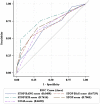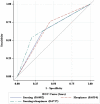Validation of STOP, STOP-BANG, STOP-BAG, STOP-B28, and GOAL screening tools for identification of obstructive sleep apnea in patients with Parkinson disease
- PMID: 36004740
- PMCID: PMC9806789
- DOI: 10.5664/jcsm.10262
Validation of STOP, STOP-BANG, STOP-BAG, STOP-B28, and GOAL screening tools for identification of obstructive sleep apnea in patients with Parkinson disease
Abstract
Study objectives: Obstructive sleep apnea (OSA) is common in Parkinson disease (PD). Questionnaires can be used as screening tools and have been used as a surrogate definition of OSA in large-scale research. This study aimed to validate the performance of STOP, STOP-BANG, STOP-BAG, STOP-B28, and GOAL and OSA predictors as tools to identify OSA in PD.
Methods: Data were analyzed from a PD cohort study in which OSA was diagnosed using laboratory polysomnography. We calculated sensitivity and specificity of each questionnaire for OSA using different definitions and performed receiver operating characteristics curve analysis. Linear regression was used to assess adjusted associations between questionnaires and outcomes: Montreal Cognitive Assessment, Epworth Sleepiness Scale, and Movement Disorder Society revision of the Unified Parkinson Disease Rating Scale.
Results: Questionnaire data were available for 68 PD patients (61.8% male, mean age 64.5 [standard deviation 9.9] years, and Hoehn and Yahr score 2.1 [0.8]). OSA (apnea-hypopnea index ≥ 15 events/h) occurred in 69.4% of participants. STOP-B28 ≥ 2 presented a higher sensitivity for OSA than STOP ≥ 2 (0.76 vs 0.65, respectively) and slightly lower specificity (0.65 vs 0.70, respectively). GOAL ≥ 2 had the highest sensitivity but poor specificity. Loud snoring had sensitivity 0.63 and specificity 0.65. STOP and snoring were significantly associated with Montreal Cognitive Assessment, Epworth Sleepiness Scale, and Movement Disorder Society revision of the Unified Parkinson Disease Rating Scale (total, motor, and nonmotor); STOP-BANG, STOP-BAG, and STOP-B28 showed associations with most outcomes, but the GOAL showed none.
Conclusions: The STOP-B28 followed by STOP and presence of loud snoring alone seem to have the best overall properties to identify PD patients with OSA, whose clinical characteristics differ from the general population with OSA.
Citation: Gomes T, Benedetti A, Lafontaine A-L, Kimoff RJ Robinson A, Kaminska M. Validation of STOP, STOP-BANG, STOP-BAG, STOP-B28, and GOAL screening tools for identification of obstructive sleep apnea in patients with Parkinson disease. J Clin Sleep Med. 2023;19(1):45-54.
Keywords: Parkinson; aging; obstructive sleep apnea; questionnaire; screening; validation.
© 2023 American Academy of Sleep Medicine.
Conflict of interest statement
All authors have seen and approved the manuscript. The work was performed at the McGill University Health Centre. The study was funded by the Research Institute of the McGill University Health Centre (MUHC), the Department of Medicine of the MUHC and the American Thoracic Society Foundation, with support from the Canadian Sleep and Circadian Network. Andrea Benedetti reports research grants from the Canadian Institutes of Health Research and salary support from Fonds de Recherche du Québec–Santé chercheur boursier, served on Advisory Boards (Abbvie, Sunovion, and Paladin). Richard John Kimoff reports research grants from the Canadian Institutes of Health Research, The Multiple Sclerosis Society of Canada, Fonds de Recherche du Quebec–Santé, Philips-Respironics Inc., ResMed Inc., and VitalAire Inc. Marta Kaminska reports research grants and in-kind support from Philips, VitalAire Inc., the American Thoracic Society Foundation, Canadian Institutes for Health Research, and Weston Brain Institute; Advisory Committee for Biron Soins du Sommeil; Advisory Board for Jazz Pharmaceuticals. The other authors report no conflicts of interest.
Figures
Similar articles
-
Screening for obstructive sleep apnea: comparing the American Academy of Sleep Medicine proposed criteria with the STOP-Bang, NoSAS, and GOAL instruments.J Clin Sleep Med. 2023 Jul 1;19(7):1239-1246. doi: 10.5664/jcsm.10546. J Clin Sleep Med. 2023. PMID: 36872648 Free PMC article.
-
Exploring the STOP-BANG questionnaire for obstructive sleep apnea screening in seniors.J Clin Sleep Med. 2020 Feb 15;16(2):199-206. doi: 10.5664/jcsm.8166. Epub 2020 Jan 13. J Clin Sleep Med. 2020. PMID: 31992408 Free PMC article.
-
Diagnostic performance of screening tools for the detection of obstructive sleep apnea in people living with HIV.J Clin Sleep Med. 2022 Jul 1;18(7):1797-1804. doi: 10.5664/jcsm.9964. J Clin Sleep Med. 2022. PMID: 35383569 Free PMC article.
-
Diagnostic accuracy of the Berlin questionnaire, STOP-BANG, STOP, and Epworth sleepiness scale in detecting obstructive sleep apnea: A bivariate meta-analysis.Sleep Med Rev. 2017 Dec;36:57-70. doi: 10.1016/j.smrv.2016.10.004. Epub 2016 Nov 5. Sleep Med Rev. 2017. PMID: 27919588 Review.
-
Use and Performance of the STOP-Bang Questionnaire for Obstructive Sleep Apnea Screening Across Geographic Regions: A Systematic Review and Meta-Analysis.JAMA Netw Open. 2021 Mar 1;4(3):e211009. doi: 10.1001/jamanetworkopen.2021.1009. JAMA Netw Open. 2021. PMID: 33683333 Free PMC article.
Cited by
-
Screening Strategies for Sleep-Disordered Breathing in Patients With Spinal Cord Injury in a Tertiary Care Rehabilitation Center.Respir Care. 2024 Aug 24;69(9):1116-1128. doi: 10.4187/respcare.11726. Respir Care. 2024. PMID: 38889927
-
The relationship between obstructive sleep apnea and visual hallucinations in PD patients: a polysomnography study.Front Neurol. 2024 Jan 11;14:1275660. doi: 10.3389/fneur.2023.1275660. eCollection 2023. Front Neurol. 2024. PMID: 38274875 Free PMC article.
References
-
- Chaudhuri KR , Odin P , Antonini A , Martinez-Martin P . Parkinson’s disease: the non-motor issues . Parkinsonism Relat Disord. 2011. ; 17 ( 10 ): 717 – 723 . - PubMed
-
- Public Health Agency of Canada (PHAC) . Parkinsonism in Canada, including Parkinson’s Disease: Highlights from the Canadian Chronic Disease Surveillance System Ottawa (ON); 2018. . https://www.canada.ca/en/public-health/services/publications/diseases-co... . Accessed July 29, 2020.
Publication types
MeSH terms
Grants and funding
LinkOut - more resources
Full Text Sources
Medical



